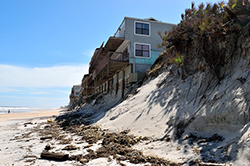 As a contractor, your contractors pollution insurance covers any erosion you cause. You want to follow all federal, state and local erosion control guidelines, though, as you prevent runoff, protect ecosystems and avoid fines. Consider nine effective construction site erosion control techniques.
As a contractor, your contractors pollution insurance covers any erosion you cause. You want to follow all federal, state and local erosion control guidelines, though, as you prevent runoff, protect ecosystems and avoid fines. Consider nine effective construction site erosion control techniques.
-
- Reforestation
Restore or restock woodlands around the property to increase soil retention and reduce degradation. Fairly simple to install, you only need seedlings or saplings, dibbers and measuring ropes.
- Reforestation
-
- Buffer Strip
Narrow strps of permanent vegetation slow runoff and trap sediment. The root system controls soil erosion caused by winds and reduces landslide risk, too.
- Buffer Strip
-
- Geotextile Roll
Made from coconut, straw or similar fibers and bound together with mesh rope, geotextile rolls cover newly graded soil and prevent bank erosion. Vegetation can be planted over the geotextile roll to increase stability. Over time, the materials will biodegrade and cause no harm to the environment. Easy to install and low maintenance, this erosion control technique is best for small streams and stable water levels.
- Geotextile Roll
-
- Brush Mattress
A system of branches and stakes, a brush mattress is often used on banks near perennial streams. This biodegradable erosion technique can be washed away in heavy rain, but it is easy to install and maintain.
- Brush Mattress
-
- Gabions
Use gabions, cages or containers filled with small rocks, on banks that are highly prone to erosion. While gabions aren’t always pretty, they are sturdy, easy to customize with rocks or concrete, and useful almost anywhere. Always ensure the supportive footing is secure and regularly inspect the gabions for mesh damage.
- Gabions
-
- Riprap
Rubble and rocks of all sizes and types form a riprap. It is an effective control erosion technique on embankments, bridge abutments, shorelines, streambeds and other seaside locations. Use a riprap on slopes with a rise that’s less than 2:1 or the riprap could become unstable and erode.
- Riprap
-
- Rootwad Composites
Stabilize stream banks, lower stream flow velocities and provide aquatic habitats for wildlife when you install rootwad composites. They incorporate interlocking tree material on the base of stream slopes. Complicated to install, this erosion control is cost effective.
- Rootwad Composites
-
- A-Jacks
Placed at the base of slopes, A-Jacks consist of interlocking cement stakes. They increase stability and are useful for high erosion areas. While they’re available in a variety of sizes, they do not biodegrade.
- A-Jacks
-
- Tree Revetment
Anchor wood to the bank with a tree revetment. It reduces water flow velocity but is not recommended for high erosion areas. This technique requires ongoing maintenance, too.
- Tree Revetment
With these nine erosion control techniques, you protect your job site and the environment. Determine which technique is right for each individual project, and update your contractors pollution insurance policy regularly to protect your business





